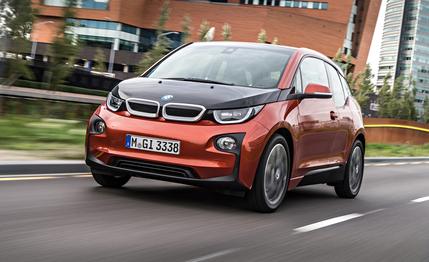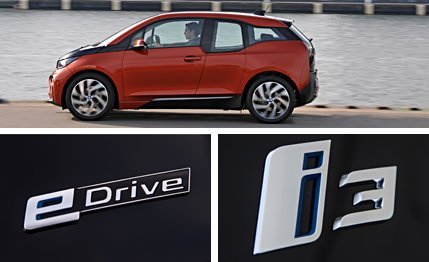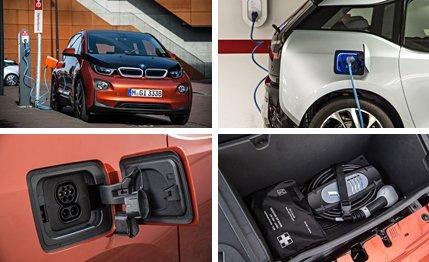
 First Drive Review
First Drive Review
For years, BMW purists have been complaining that the company is straying from the core values that made its products great, and its recent foray into purpose-built electric and hybrid vehicles with its i sub-brand has only amplified those fears. When we traveled to Amsterdam to drive the i3 in final production trim, the picture got even more ominous. BMW isn’t just screwing around with a couple of electric toys; it’s diving head first into the concept of an electrified future, developing smartphone apps and even constructing a DC-charging array between Munich and Berlin similar in concept to the Tesla Supercharger network. But perhaps the most important thing we learned is this: The i3 doesn’t stray very far at all from what makes most BMWs great; it simply carries those principles into a new realm.
The car is different enough from anything else that not only BMW—and, indeed, any other car company—has ever made that it’s easy to understand the concerns. BMW calls the i3’s construction method “LifeDrive,” but we’d have gone with something less contrived and more direct, with a name more along the lines of “Revolutionary.” This is the first production application of a construction concept that’s been kicking around for more than a decade, the so-called skateboard platform, in which the chassis is one self-contained unit and the passenger cell is another. Think of it as the ultimate evolution of body-on-frame construction.


Sick Deck, Bro
BMW calls its skateboard the Drive Module, and fashions it almost entirely from aluminum. The framework surrounding the 450-pound lithium-ion battery pack, the front control arms, and even the bolts that attach the chassis to the body are all aluminum. Only the rear suspension links are steel. Atop the Drive module sits the Life module, which is crafted primarily from carbon fiber. The body structure and roof panel are made from that stuff, while the body panels are composite. Throw in some other lightweight materials, such as a magnesium dash brace and hemp-reinforced interior plastics (maybe that’s why the drive program was conducted in Amsterdam), and the whole thing (with range-extender) weighs about 2900 pounds. That’s roughly 450 less than a Nissan Leaf and in the same mass neighborhood as a Chevy Spark, an entirely conventional car that is a bit smaller than the i3. Remember that business about BMW core values? Naturally, those 2900 pounds are evenly distributed between the front and rear axles.
The electric motor sits at the back of the Drive module, offset to the driver’s side. The lithium-ion battery pack, mounted in the floor ahead of the motor, weighs 450 pounds and holds 22 kWh of juice, 38 percent more than the Chevrolet Volt’s. That’s good for a claimed 80 to 100 miles of range, and putting the car into Eco Pro or Eco Pro Plus modes adds in the neighborhood of 12 and 25 percent. The pack needs about three hours to get a full charge on a 220-volt circuit at home. On a 440-volt, high-amp DC fast-charging source (that you are exceedingly unlikely to have at home), it’ll get from dead to 80 percent in 20 minutes, or topped off in 30. The motor produces a max of 170 horsepower and 184 lb-ft of torque.


A range-extending internal-combustion engine is optional, but never drives the wheels, so don’t figure its output (34 horsepower) into the total. Instead, the engine simply maintains the battery charge. Borrowed from BMW’s scooter portfolio, the inline-two displaces 650 cc and nests next to the electric motor at the back of the car. Between it and its 2.4-gallon fuel tank—mounted between the front axle and the firewall, which means you have to pop the hood to refuel the car—the range extender adds about 310 pounds to the i3. To see exactly how this affects the i3’s weight distribution, we’ll have to weigh a pair ourselves. All BMW would say is that it’s close to that of the electric-only version.
Electric? Yes. BMW? Yes.
That weight balance figures heavily into the i3’s on-road performance. There’s no appreciable feedback from the (of course) electric power steering, but it is nonetheless very quick and precise. On our first pass through a tight slalom course, we clipped two cones because we were unprepared for the i3’s quick turn-in behavior. The car is wonderfully balanced and neutral, right up until its spindly 155/90R19s lose their grip. There’s no off switch for the stability control, but the aluminum Drive module’s rigidity imparts a solid structural feel, with admirable body control and a confident, controlled ride. There is none of the stripped-out, tinny feeling found in many EVs. BMW’s ground-up approach netted acceptably low poundage without having to scrimp on noise insulation and the like.